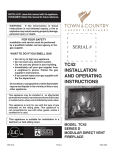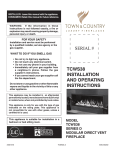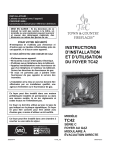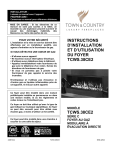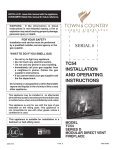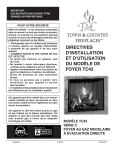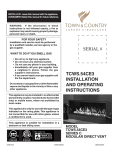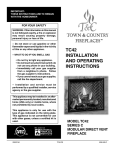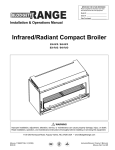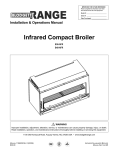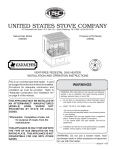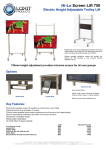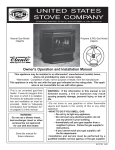Download PGS TC36 User's Manual
Transcript
IMPORTANT: THESE INSTRUCTIONS ARE TO REMAIN WITH THE HOMEOWNER FOR YOUR SAFETY WARNING: If the information in this manual is not followed exactly, a fire or explosion may result causing property damage, personal injury or loss of life. -- Do not store or use gasoline or other flammable vapours and liquids in the vicinity of this or any other appliance. -- WHAT TO DO IF YOU SMELL GAS • Do not try to light any appliance. • Do not touch any electrical switch; do not use any phone in your building. • Immediately call your gas supplier from a neighbour’s phone. Follow the gas supplier’s instructions. • If you cannot reach your gas supplier, call the fire department. --Installation and service must be performed by a qualified installer, service agency or the gas supplier. MODEL This appliance may be installed in an aftermarket permanently located, manufactured home (USA only) or mobile home, where not prohibited by local codes. TC36 AR SERIES B MODULAR DIRECT VENT FIREPLACE This appliance is only for use with the type of gas indicated on the rating plate. This appliance is not convertible for use with other gases, unless a certified kit is used. 050505-36 INSTALLATION AND OPERATING INSTRUCTIONS 36ARB2 5056.428091 Contents CAUTION .............................................................................................................. 3 SAFETY ................................................................................................................ 3 INSTALLATION REQUIREMENTS ....................................................................... 5 TOP STANDOFFS................................................................................................. 5 LOCATING THE FIREPLACE .............................................................................. 5 FRAMING AND FINISHING .................................................................................. 6 HEARTH EXTENSION .......................................................................................... 8 CONTROL BOX .................................................................................................... 8 VENTING............................................................................................................. 10 WALL TERMINATION VENTING ........................................................................ 10 ROOF TERMINATION VENTING ....................................................................... 15 VENT TERMINAL CLEARANCE ........................................................................ 17 INSULATED COLLAR SHIELD .......................................................................... 18 VENT PIPE SEALANT ........................................................................................ 18 VENT RESTRICTOR ADJUSTMENT ................................................................. 19 MANUFACTURED (MOBILE) HOME ................................................................. 19 GAS SUPPLY ...................................................................................................... 20 OPTIONAL WALL SWITCH ................................................................................ 20 WINDOW FRAME REMOVAL ............................................................................ 21 FIREBOX PANELS INSTALLATION .................................................................. 22 FIRST FIRE ......................................................................................................... 23 OPERATING ....................................................................................................... 23 LIGHTING INSTRUCTIONS - Millivolt Valve .................................................... 23 LIGHTING INSTRUCTIONS - Electronic Valve ................................................ 24 MAINTENANCE .................................................................................................. 25 APPENDIX A ....................................................................................................... 25 REPLACEMENT PARTS .............................................................................. 26 REPLACEMENT PARTS-MILLIVOLT CONTROL ASSEMBLY................... 27 REPLACEMENT PARTS - ELECTRONIC CONTROL ASSEMBLY ............ 28 ELECTRONIC VALVE WIRING DIAGRAM .................................................. 29 WALL TERMINATION KIT ........................................................................... 30 WALL SHIELD/CEILING FIRESTOP THIMBLE .......................................... 30 ROOF TERMINATION KIT ........................................................................... 31 VENT PIPE DIMENSIONS............................................................................ 32 VENT OFFSET CHART ................................................................................ 33 VARIOUS GAS SUPPLY CONNECTIONS................................................... 34 SAFETY LABEL LOCATION........................................................................ 35 2 36ARB2 050505-36 CAUTION SAFETY FOR YOUR SAFETY - Do not install or operate your Town and Country fireplace without first reading and understanding this manual. Any installation or operational deviation from the following instructions voids the Town and Country FireplacesTM Warranty and may prove hazardous. This appliance and its individual shutoff valve must be disconnected from gas supply piping system during any pressure testing of that system at test pressures in excess of 1/2 psig (3.5 kPa). This appliance must be isolated from the gas supply piping system by closing its individual manual shutoff valve during any pressure testing of the gas supply piping system at test pressures equal to or less than 1/2 psig (3.5 kPa). Note: When lit for the first time, the appliance will emit a slight odour for a couple of hours. This is due to the curing of paints, sealants and lubricants used in the manufacturing process. This condition is temporary. Open doors and windows to ventilate area. Smoke and fumes caused by the curing process may cause discomfort to some individuals. Do not use the fireplace if any part has been under water. Immediately call a qualified service technician to inspect the fireplace and to replace any part of the control system and any gas control which has been under water. Due to high temperatures, this gas appliance should be located out of traffic and away from furniture and draperies. Children and adults should be alerted to the hazards of high surface temperatures and should stay away to avoid burns or clothing ignition. Young children should be carefully supervised when they are in the same room as the appliance. Clothing or other flammable material should not be placed on or near the appliance. Any grill, panel or door removed for servicing the unit must be replaced prior to operating. Failure to do so may create a hazardous condition. Installation and repair should be done by a qualified service person. The appliance should be inspected before use and at least annually by a professional service person. More frequent cleaning may be required due to excessive lint from carpeting, bedding material, etc. It is imperative that control compartments, burners and circulating air passageways of the appliance be kept clean. It is our policy that no responsibility is assumed by the Company or by any of its employees or representatives for any damages caused by an inoperable, inadequate, or unsafe condition which is the result, either directly or indirectly, of any improper operation or installation procedures. Fig # 1 FIREPLACE DIMENSIONS CENTER OF FLUE OUTLET 050505-36 TOP STANDOFFS 36ARB2 3 Fig. # 2 COMBUSTIBLE FRAMING AND FINISH WALL ABOVE STANDOFFS STEEL FRAMING MAY USE COMBUSTIBLE FACING MATERIAL IN THIS AREA STANDOFFS NON-COMBUSTIBLE FINISH MATERIAL SEE FIG #7 NON-COMBUSTIBLE ZONE. DO NOT INSTALL ANY COMBUSTIBLE MATERIAL, ELECTRICAL WIRING OR GAS PLUMBING IN THIS AREA. D E F A B C TOP OF LINTEL BAR FIREPLACE FRONT MANTEL CLEARANCE CHART MANTEL * CLEARANCE REF. A 9" D 12" B 6" E 6 3/4" C 3" F 1 1/2" REF. Minimum Clearances to Combustibles: (0 mm) Back standoffs ..................... 0 in. (0 mm) Top standoffs ....................... 0 in. (0 mm) Bottom of appliance ............. 0 in. (0 mm) Adjacent sidewall ................. 4 in. (102 mm) Ceiling to appliance ........... 24 in. (610 mm) MANTEL DEPTH Fig. # 3 ING IL CE *Mantel to appliance ..........See Figure #2 M A N TE L Side standoffs ...................... 0 in. ** AD J WA ACE N MA LL O T N R SU TEL PP OR T **Maximum Mantel extension ..........See Figure #2 4 Mantel support ..................... 4 in. (102 mm) Vertical vent pipe ........... 1-3/4 in. (45 mm) Horizontal vent pipe Top ........................... 1-3/4 in. Sides ........................ 1-3/4 in. Bottom ...................... 1-3/4 in. (45 mm) (45 mm) (45 mm) 36ARB2 UNIT MAY BE RECESSED UP TO 6" WITH NON-COMBUSTIBLE MASONRY TYPE MATERIAL 050505-36 INSTALLATION REQUIREMENTS The Town & Country Fireplace installation and venting must conform to the current CAN/CGA-B149 installation code (in Canada) or the current National Fuel Gas Code, ANSI Z223.1 (in the USA), and approved per local codes. Only qualified (licensed or trained) personnel should install this product. In the state of Massachusetts, only a licensed Plumber and Gas Fitter may install this product. Fig. # 4 Fig. # 5 TOP STANDOFFS TOP STANDOFFS The top standoffs are shipped loose inside the fireplace and must be installed on top of the fireplace as shown in fig. #4. Do this once the fireplace is on site and in position. LOCATING THE FIREPLACE In planning the installation for the fireplace, it is necessary to determine where the unit is to be installed, location of vent system and where gas supply piping may be plumbed. Various installations are possible, such as, into an existing wall, a corner, a built-in wall or a wall projection (see Fig. #5). Due to high temperatures, do not locate this fireplace in areas of high traffic or near furniture or draperies. The minimum clearances from the fireplace to combustible surfaces must be adhered to and are shown on Fig. # 2 and 3. Examples of Common Locations SEE FIG #9 FOR DIMENSIONS CAUTION: When selecting a location, ensure that there is adequate room on the right hand or left hand side of the fireplace for the control box. 050505-36 36ARB2 5 FRAMING AND FINISHING Note: The fireplace must be in place and venting installed before framing in or building an enclosure around the unit. The Town & Country Fireplace must be framed in as described below or totally enclosed with non-combustible material, such as facing brick. Determine the total thickness of facing material to be used. A thickness of 3/4" will allow the finishing surface to be flush with the front of the unit. If preferred, additional masonry type non-combustible material can be installed above and to the sides up to 6 inches proud of the appliance. The finishing material must not interfere with glass frame access. A Steel Stud Framing Kit is supplied with the fireplace and must be used unless the fireplace is totally enclosed with non-combustible material. Assemble the framing kit as per it's instructions. Attach the steel frame to the fireplace once Fig. # 6 the fireplace is in its final position. Secure the steel frame to the framing brackets on each side of the unit. Ensure that the studs are set back far enough to allow for thickness of finishing surface. The sides, back and top of the fireplace can be framed in up to the steel studs and the fireplace standoffs using conventional lumber. Consult local building codes for specific requirements. Due to high temperatures, concrete board is supplied with the fireplace and must be used to sheet in the front of the fireplace, extending 12" above and 4 1/2" to the side of the framing edge bars. See figure #7. Standard sheetrock (drywall) may be used beyond this. Chase Insulation: When installing this fireplace against a non-insulated exterior wall or chase, it is recommended that the outer walls be insulated to same degree as other exterior walls. Do not place fireplace directly against the insulation. Cover the insulation and plastic vapour barrier with a solid surface, such as drywall (sheetrock). Consult local codes. Do not insulate or use plastic vapour barrier within the framing kit. STEEL STUD FRAMING KIT DIMENSIONS (TC36.BFRKITA) NONCOMBUSTIBLE ZONE. DO NOT INSTALL ANY COMBUSTIBLE MATERIAL, ELECTRICAL WIRING, INSULATION, PLASTIC VAPOUR BARRIER OR GAS PLUMBING WITHIN THE STEEL STUD FRAMING ALL OTHER FRAMING CAN BE DONE WITH CONVENTIONAL LUMBER 6 36ARB2 050505-36 Fig. # 7 CONCRETE BOARD DETAIL Fig. # 8 NON-COMBUSTIBLE RECESSED INSTALLATION DETAIL CONCRETE BOARD NON-COMBUSTIBLE MASONRY TYPE MATERIAL CONCRETE BOARD STEEL STUDS 6" Concrete board (or other noncombustible material) must extend 12" above and 4 1/2" to the sides of the framing edges. Fig. # 9 MINIMUM COMBUSTIBLE FRAMING DIMENSIONS Including Sheetrock CAUTION: When framing for the fireplace, ensure adequate space is provided for the control box. Do not install the control box above the fireplace. WARNING: Framing dimensions will vary with location of fireplace, which may need to be adjusted to accommodate control box placement and vent installation. Fireplace should be in it's final location before framing. 050505-36 36ARB2 7 CONTROL BOX Fig. # 10 The gas control system is housed in a control box remote of the fireplace. Flexible conduits attach the control box to the fireplace and house all the plumbing and wiring to the burner. This unique design allows the control box to be mounted in a variety of positions on the right or left side of the fireplace. The box can be framed into the front right or left face or the right or left sidewall of the fireplace enclosure. As the control system is attached at the factory to exit the right side of the fireplace, please see "Control Box Relocation" section to move the control box to exit the left side. MANUAL MILLIVOLT VALVE PILOT FLAME INDICATOR BATTERY SPARK IGNITER CONTROL DOOR AND FRAME Caution: When positioning the control box, do not over bend the conduit or use excessive force, as damage may occur. 1) Remove window frame latch tool and set aside. 2) Remove 4 screws holding control panel in place and carefully lift off over the control knobs, being sure not to damage wires and connections to the "Pilot Flame" indicator (millivolt control system only). Carefully disconnect wires from indicator, and set aside. 3) Attach control box to framing at predetermined depth, allowing room for wall finishing material. Side brackets can be adjusted for a trim fit. 4) Attach control box to framing at predetermined depth, allowing room for wall finishing material. Side brackets can be adjusted for a trim fit. 5) Replace door/inner frame assembly and fasten in place. Note: Gas supply plumbing must be completed and the spark igniter battery or backup batteries installed before reinstalling the front control panel. BURNER SWITCH CONDUIT GAS VALVE 6) Reconnect "Pilot Flame" indicator wiring and reinstall control panel. Fig. # 11 WINDOW FRAME HEARTH EXTENSION 1" MAX 1/4" HEARTH EXTENSION 8 36ARB2 SUBFLOOR While a hearth extension is not required for this fireplace, one is recommended for aesthetic reasons. The hearth extension should be noncombustible and must not be any more than 1" above the bottom of the fireplace. If thicker, fireplace must be raised up accordingly. Caution: Hearth extensions thicker than 1" will interfere with the window frame. WINDOW TRACK 050505-36 CONTROL BOX LOCATION AND FRAMING DETAIL Fig. # 12 4 1/4" CAUTION: 12" - A 2 foot service access clearance is recommended in front of the control box. - If recessed into a masonry wall, allow for control door and frame removal. - If flush mounted on a masonry wall, allow for conduit to exit out the bottom of control box. 9 3/8" POSSIBLE CONTROL BOX LOCATIONS LEFT OR RIGHT OF THE FIREPLACE DO CO N O O NT T I VE R N R OL ST A FI REBO LL PL X AC E Caution: When positioning the control box, do not over bend the conduit or use excessive force, as damage may occur. Alternately, the control may be repositioned from the right side of the fireplace to the left side. 050505-36 DO NOT INSTALL CONTROL BOX OVER FIREPLACE 36ARB2 9 VENTING WALL TERMINATION VENTING Before installing venting for this unit, the installer should read these instructions to insure that the proper vent configuration has been selected. Use only Town and Country Termination kits #: TCVT.WTA - Wall Termination Kit TCVT.RTA - Roof Termination Kit Exterior wall opening: Determine the exact position of the fireplace so that the vent pipe is centred (if possible) between two building framing members. Consult your local building codes prior to proceeding. The vent kit will accommodate up to a maximum wall thickness of 12 inches. Vent system components approved for use with the Town and Country Fireplace are shown in Figure #13. 1) Having determined the position of the fireplace, cut and frame a 14 1/2 inch opening centred at a minimum height of 68 1/2 inches above the floor. The opening may be round or square. Height of the opening will vary with each installation. As the horizontal vent run increases, so does the minimum vertical rise (see Fig. #17). Various combinations of vertical and horizontal runs may be used. Refer to # 17 and 18 for details. For optimum performance and flame appearance, keep the vent length to a minimum and limit the number of elbows. Connections between each vent system component must be tightly joined, secured with sheet metal screws and sealed. A horizontal run of vent should have a 1/4" rise for every 1 ft. of run towards the termination. CAUTION: UNDER NO CONDITION SHOULD COMBUSTIBLE MATERIAL BE CLOSER THAN 1 3/4 INCHES FROM THE TOP AND 1 3/4 INCHES FROM THE SIDES OF A HORIZONTAL SECTION AND 1 3/4 INCHES FROM THE VERTICAL SECTIONS OF THE VENT PIPE. IMPORTANT: When locating the opening, it should be noted that vent terminal clearances must be maintained. See "Vent Terminal Clearances" section for proper clearances. A minimum 2 foot length of pipe is required for any wall termination. With this minimum vertical rise in combination with a 90° elbow, a maximum horizontal run of 18 inches is permitted (see Fig. #17 and 18). For longer horizontal runs greater than 18 inches, increase vertical rise appropriately. The rise and run must be constrained to the boundaries of the chart shown in figure #17. The horizontal run of vent must have a 1/4" rise for every 1 ft. of run towards the termination. Fig. # 13 Vent System Components Town & Country 12" Pipe Length ........................... TCVT.811X12 18" Pipe Length ........................... TCVT.811X18 24" Pipe Length ........................... TCVT.811X24 48" Pipe Length ........................... TCVT.811X48 18" Adjustable Pipe Length ......... TCVT.811X12ADJ 45° Elbow .................................... TCVT.811XLB45 90° Elbow .................................... TCVT.811XLB90 Wall/Offset Support ..................... TCVT.811XOS Wall Termination Kit .................... TCVT.WTA Roof Termination Kit .................... TCVT.RTA Wall Shield/Ceiling Firestop......... TCVT.THIMA Roof Flashing, Adjustable............ TCVT.811FLADJ Roof Flashing, Flat ...................... TCVT.811FLFLT Roof Flashing, Steep ................... TCVT.811FLSTP or any that fits 11" pipe 10 36ARB2 050505-36 Fig. # 14 WALL THIMBLE AND VENT MUST NOT PROTRUDE BEYOND SIDING Wall thimble: Where a vent pipe passes through a combustible wall, a wall thimble/shield must be used to retain insulation and maintain proper clearances. The wall thimble may be cut to length for various wall thicknesses up to 12" thick. Measure the wall thickness including the siding. Trim the shield to match the wall thickness. Position the wall thimble from inside through the 14-1/2" opening. Properly adjusted, the thimble should be flush with the outer wall surface. Fig. # 15 TRIM TO LENGTH 050505-36 36ARB2 11 Vent pipe: Install vent pipe through the wall thimble and attach to flue outlet collar on top of the fireplace. Secure all joints with screws and seal with approved "High Temp." self-adhesive aluminum tape provided (see VENT PIPE SEALANT section). The fireplace position may need to be adjusted to ensure that the vent pipe does not protrude beyond the outer wall or be recessed any more than 12 inches with the inner pipe. Fig. #16 Wall vent terminal: 1) Engage the 8" vent collar with the vent pipe and slide terminal into place. Attach the terminal to the outside wall. The vent terminal must not be recessed into the exterior wall or siding. 2) Caulk in place to prevent any moisture entering the building. NOTE: MINIMUM CLEARANCES TO THE VENT TERMINAL MUST BE MAINTAINED (see Fig. #17). 14 1/2" FRAMED OPENING WALL SHIELD THIMBLE TCVT.THIMA ELBOW TCVT.811XLB90 HORIZONTAL TERMINAL TCVT.9360 24" VENT PIPE TCVT.811X24 INSULATED COLLAR SHIELD TC36.9709 12" VENT PIPE TCVT.811X12 * * Minimum height from the floor to center of the opening with a maximum horizontal run of 18" using TC Vent. The height will need to be increased with a longer horizontal run . 12 36ARB2 050505-36 WALL TERMINATION VENTING CHART Fig. # 17 D A B C Minimum rise Pipe length Maximum run Pipe length Maximum 68 1/2” 24” 18" 1' 74 1/2” 30” 76" 5' 80 1/2” 36” 11' 2 1/8" 10' 86 1/2” 42” 16' 15' 92 1/2” 48” 20’ 10 1/4” 20' For other rise/run combinations see chart below 24" Pipe length minimum NOTE: The vent must not exceed a total length of 68 feet. Any combination of rise and run may be used but must be constrained to the boundaries of this chart. A total of 3 90° elbows or combination of other elbows equalling 90° can be used without reducing horizontal run. For each additional 90° elbow, or an equal combination of elbows, reduce horizontal vent run by 2 feet. Ensure vent pipe is properly supported. * 050505-36 Minimum Vent Pipe Centerline Height 36ARB2 13 Fig. # 18 ROOF TERMINATION VENTING CHART D A B C Minimum rise Pipe length Maximum run Pipe length Maximum 68 1/2” 24” 26 5/16" 1' 74 1/2” 30” 84 3/8" 5' 80 1/2” 36” 11' 10 1/2" 10' 86 1/2” 42” 16' 8 1/2" 15' 92 1/2” 48” 21’ 6 5/8” 20' For other rise/run combinations see chart below 24" Pipe length minimum 14 36ARB2 NOTE: The vent must not exceed a total length of 68 feet. Any combination of rise and run may be used but must be constrained to the boundaries of this chart. A total of 4 90° elbows or combination of other elbows equalling 90° can be used without reducing horizontal run. For each additional 90° elbow, or an equal combination of elbows, reduce horizontal vent run by 2 feet. Ensure vent pipe is properly supported. 050505-36 ROOF TERMINATION VENTING Fig. # 20 Ceiling opening: A 1) Determine the exact position of the fireplace so that the vent pipe is centered (if possible) between two building framing members. Lay out the vent system path, minimizing the number of elbows and length of vent. Consult your local building codes prior to proceeding. 14 1/2" 2) Cut and frame a 14 1/2" opening in the floor, ceiling and roof where the vent system will pass. Size of the opening in the roof may need to be increased as the pitch of the roof increases. Avoid cutting rafters. B Ceiling firestop: Where a vent pipe passes through a floor or ceiling, a ceiling firestop must be used to retain insulation and maintain proper clearances. From below, push the ceiling firestop through the opening and secure in place. If the firestop is used to penetrate a floor, the outer shield may be trimmed in length. If the firestop penetrates into an attic, leave the shield full length to keep insulation away from the vent pipe. Additionally, after the vent pipe is in place, install a storm collar on top of the shield. This will prevent loose insulation from falling into the area between the vent pipe and the shield. Size of the opening will have to increase with the pitch of the roof to ensure a 1 3/4 inch air space clearance between vent pipe and combustibles. Roof Pitch 0/12 4/12 6/12 8/12 12/12 A 14 1/2" 16 1/2" 18" 19 3/4" 24" B 7 1/4" 8 3/4" 10" 11" 13 3/4" Vent pipe: Fig. # 19 VENT PIPE 1) Install the first section of vent pipe into the collar on top of the fireplace. Secure in place with screws and seal with approved "High Temp." self-adhesive aluminum tape provided. 2) Continue adding vent pipe lengths up and through the firestop(s) and through the roof. The vent pipe must extend at least 24" above the roof. Seal the vent pipe as per "Vent Pipe Sealant" section. Roof support bracket: Slip the roof support bracket down over the vent pipe. Rotate the 90° brackets to accommodate roof pitch. Attach the brackets to the roof joists with nails or building screws. Tighten the band around the vent pipe and secure in place with screws. ROOF SUPPORT BRACKET (TCVT.93915) 050505-36 36ARB2 15 Roof vent terminal: 1) Place the roof flashing over top of the vent pipe and nail securely to the roof using roofing nails, top and sides UNDER shingles, lower end OVER shingles to provide a watershed. Make weather tight by sealing with a roofing compound (see Fig. #21). 2) Place the storm collar down over the vent pipe until it is level. Tighten storm collar for a snug fit. Apply a thick horizontal ring of mastic around the pipe at top of the storm collar (see Fig. #21). 3) Lower the roof vent terminal cap over the vent pipe and secure in place with screws provided (see Fig. #21). Seal screw heads and joint with caulking to prevent any moisture entering the venting system. Fig. # 21 VERTICAL TERMINATION CAP (TCVT.9365) VENT PIPE MASTIC STORM COLLAR (TC42.90665) FLASHING 16 36ARB2 Note: Adjustable for various roof pitches, from flat roof to 12/12 pitch roof. 050505-36 VENT TERMINAL CLEARANCE VENT TERMINAL MINIMUM CLEARANCES TO ADJACENT STRUCTURES Fig. # 22a Minimum clearances to the vent terminal must be maintained as shown in figure #22a & b. Measure clearances to the nearest edge of termination hood. 36" (91.5 cm) 24" (61 cm) NOTE: Vent terminal must not be recessed into a wall or siding. NOTE: LOCAL CODES OR REGULATIONS MAY REQUIRE DIFFERENT CLEARANCES. 24" (61 cm) 48" (122 cm) ADJACENT STRUCTURES OR FENCE VENT TERMINAL MINIMUM CLEARANCES Fig. # 22b G INSIDE CORNER DETAIL V A H D E C V L V B F FIXED CLOSED B V OPENABLE V OPENABLE V FIXED CLOSED I G V B J A A V VENT TERMINAL A AIR SUPPLY INLET A= clearances above grade, veranda, porch, deck, or balcony [* 12 inches (30 cm) minimum] B= clearance to window or door that may be opened [* 12 inches (30 cm) minimum] C= clearance to permanently closed window [minimum 12 inches (30 cm) recommended to prevent condensation on window] D= vertical clearance to ventilated soffit located above the terminal within a horizontal distance of 2 feet (60 cm) from the edge of the terminal [30 inches (76 cm) minimum] E= clearance to unventilated soffit [30 inches (76 cm) minimum] F= clearance to outside corner [6 inches (15 cm) minimum] G= clearance to inside corner [6 inches (15 cm) minimum] AREA WHERE TERMINAL IS NOT PERMITTED M V K A G GAS METER H= * not to be installed above a meter/regulator assembly within 3 feet (90 cm) horizontally from the center-line of the regulator I= clearance to service regulator vent outlet [* 6 feet (1.8 m) minimum] J= clearance to non-mechanical air supply inlet to building or the combustion air inlet to any other appliance [* 12 inches (30 cm) minimum] K= clearance to a mechanical air supply inlet [* 6 feet (1.8 m) minimum] L= ^ clearance above paved side-walk or a paved driveway located on public property [* 7 feet (2.1 m) minimum] M= clearance under veranda, porch, deck, or balcony [30 inches (76 cm) minimum**] ^ a vent shall not terminate directly above a side-walk or paved driveway which is located between two single family dwellings and serves both dwellings* ** only permitted if veranda, porch, deck, or balcony is fully open on a minimum of 2 sides beneath the floor* * as specified in CGA B149 Installation Codes, Note: local Codes or Regulation may require different clearances 050505-36 36ARB2 17 VENT PIPE SEALANT Fig. #23 APPROVED "HIGH TEMP." SELF-ADHESIVE ALUMINUM TAPE VENT PIPE INSULATED COLLAR SHIELD (Included) MUST BE USED. SEE SECTION BELOW VENT PIPE SEALANT All outer joints of the vent pipe must be sealed with the approved "High Temp." self-adhesive aluminum tape provided. Wrap the tape completely around the joint and press firmly in place. Fig. #24 INSULATION COVER (2 pcs.) BEND TABS INSULATED COLLAR SHIELD (Included Pt# TC36.9709) After sealing the vent pipe an insulating blanket and cover must be installed around the vent pipe, flush with the top of the unit and secured by fitting tabs through slots and bending over tabs 180° as shown in fig #24. The parts required are included. *NOTE: bending tabs to 90° away from arc bend 18 36ARB2 050505-36 VENT RESTRICTOR ADJUSTMENT Fig. # 26 WALL AND ROOF TERMINATION RESTRICTOR POSITION The vent restrictor is located on the underside of the firebox top. The unit leaves the factory with the vent restrictor wide open. The restrictor is built into the appliance for secondary air flow adjustment. Adjustment enables tuning the airflow for optimum flame appearance and performance for a wide variety of vent configurations. 48' Setting: - determine the vent height - determine the vent horizontal length - from the chart determine the restrictor position Refer to the chart in Fig. 26 for the correct position of restrictor for the vent configuration of your installation. Restrictor positions are based upon lab tests. The ideal position may vary slightly with installation. Restrictor position is too closed if the flame has the following characteristics: - Flame is excessively tall and lifting. - Flame lacks movement. - Flame soots. Restrictor position is too open if the flame has the following characteristics: - Flame height is low. - Flame has excessive movement. 40' 1" OPEN NG 3/4" OPEN LP 30' 30' 2" OPEN 22' 20' 20' To adjust the restrictor: - Loosen the screw holding the restrictor. - Push the restrictor back to its intended opening. - Tighten the screw 18' 3" OPEN 12' 10' 10' FULLY OPEN 8' Fig. # 25 VENT RESTRICTOR OPENING 6' 4' 2' 18" 4' 6' 8' 10' 12' 14' 16' 18' 20' 0' 0' MANUFACTURED (MOBILE) HOME In some jurisdictions, the Town & Country Fireplace may be installed in Manufactured Homes after the "first sale". Consult local codes for approval. The fireplace must be fastened in place. Install in accordance with the current standard Mobile Homes, CAN/CSA Z240 MH (in CANADA), and the Manufacturer's Home Construction and Safety Standard, Title 24 CFR, Part 3280 or the current Standard for Fire Safety Criteria for Manufactured Home Installations, Sites and Communities ANSI/NFPA 501A (in the U.S.A.). 050505-36 36ARB2 19 GAS SUPPLY Caution: The gas line should be installed by a qualified service person in accordance with all building codes. This section is intended as a guide for qualified technicians installing this appliance. Consult local and/or national building codes before proceeding. Recommended Thermostat Wire Size Wire Size Max. Length 14 ga............................. 100 ft. 16 ga.............................. 60 ft. 18 ga.............................. 40 ft. 20 ga.............................. 25 ft. 22 ga.............................. 18 ft. A gas supply line access hole is located at the bottom right side of the Control Box. Gas valve inlet accepts a 3/8" N.P.T. fitting. Correct gas line diameter must be used to assure proper operation. The gas control is equipped with a capture screw type pressure test port, therefore it is not necessary to provide an 1/8 inch N.P.T. plugged tapping pressure port for checking gas pressure immediately upstream of the gas supply connection to the appliance. OPTIONAL WALL SWITCH OR THERMOSTAT (Canada Only) Note: Use of a wall thermostat is only permitted in Canada. WARNING: Do not connect 110 - 120 VAC to the gas control valve or control wiring system of this unit. Correct gas pressure requirement: Min. Pressure Natural Gas Propane 5.0" wc 12.5" wc 13.9" wc 13.9" wc (For purpose of input adjustment) Max. Pressure Manifold Pressure Maximum Minimum 3.8" wc 2.1" wc 11" wc 5.5" wc Manual Millivolt Valve Only: No electrical connection is required for the gas system operation. The self-generating pilot provides current for the remote wall switch or wall thermostat (not provided). The installation of a wall switch allows for manual remote operation of fireplace, and automatic operation with a wall thermostat. Use a switch or thermostat that is millivolt rated. Position the wall switch or thermostat so that a minimum length of wire is used from the switch to the fireplace. Use appropriate wire gauge for length of wire. Connect the wall switch to the valve as shown in figure #27. MANUAL MILLIVOLT VALVE Fig # 27 INLET PRESSURE TEST POINT OPTIONAL WALL THERMOSTAT Canada Only (GASC.THERMO) GAS VALVE THERMOPILE 10 20 30 OPTIONAL REMOTE CONTROL I OR N OFF P L T O O E MANIFOLD PRESSURE TEST POINT A INDICATOR I PILOT FLAME ADJUSTMENT SCREW O L H ON OFF PI LOT TP TH * BURNER ROCKER SWITCH TP OR TH OPTIONAL WALL SWITCH * NOTE: ROCKER SWITCH MUST BE IN OFF POSITION WHEN USING OPTIONAL WALL SWITCH OR THERMOTSTAT 20 36ARB2 050505-36 WINDOW FRAME REMOVAL Warning: Turn off the fireplace, and allow ample time for the unit to cool before proceeding. Caution: The ceramic glass is very fragile, and should be handled with care. Fig # 29 UPPER FIREBOX SHIELD The window frame is held in place by two spring-loaded latches and are operated by a removable handle. The handle is located in the Control Box. 1) Insert the latch handle onto the catch located 6” down from the top corners. Rotate up to disengage each of the two catches. 2) Tilt the top of the window frame out to clear the top edge of the unit. Grasp the sides of the frame and lift up and out to disengage from its bottom track. 3) Place the window frame in a safe place to avoid damage. SIDE PANEL RETAINER Reassemble in reverse order. Fig # 30 Fig # 28 050505-36 36ARB2 21 FIREBOX PANELS INSTALLATION Fig. #32 ADJUSTABLE "V" BRACKET (HERRINGBONE .................. TCPN.7566) (TUSCAN ................................ TCPN.748) (HERITAGE RED................ TCPN.75704) For porcelin panel kit (TCPN.75702) installation see instructions provided with panel kit. The Firebox Panels have to be installed for safe operation. Do not use the fireplace without panels. Unpack and inspect all panels. The panels need to be installed before the logs are in place. Caution: The Brick Panels are very fragile, and should be handled with care. 1) Remove the log grate by removing the two screws retaining it. Screws are located behind the front legs of the grate. 2) Remove the Side Panel Retainers located on the underside of the upper firebox heatshield. The retainers are each held in place by one screw. 3) Install the Lower Rear Panel. 4) Install the Right Side Panel by inserting the bottom of the panel in first and then angling it up into position. 5) Install the Left Side Panel by inserting the bottom of the panel in first and then angling it up into position. The rear panel is held tight against the side panels by two "V" brackets located on the firebox rear wall. Although the brackets are adjusted at the factory for the best fit, some adjustment may be necessary. Adjust the angle of the bracket by hand to ensure a snug fit. Fig. # 31 REAR LOWER PANEL 6) 7) 8) 9) Install the Rear Upper Panel. Re-install the Side Panel Retainers. Install the Left and Right Front Panels. Replace the Grate. HERRINGBONE PANEL SET SHOWN REAR UPPER PANEL RIGHT SIDE PANEL LEFT SIDE PANEL REAR LOWER PANEL LEFT FRONT PANEL 22 36ARB2 RIGHT FRONT PANEL 050505-36 LIGHTING INSTRUCTIONS - Millivolt Valve FOR YOUR SAFETY READ BEFORE LIGHTING WARNING: If you do not follow these instructions exactly, a fire or explosion may result causing property damage, personal injury or loss of life. A. This appliance is equipped with an ignition device which automatically lights the pilot. Do not try to light the pilot by hand. B. BEFORE LIGHTING smell all around the appliance area for gas. Be sure to smell next to the floor because some gas is heavier than air and will settle on the floor. WHAT TO DO IF YOU SMELL GAS: - Do not try to light any appliance. - Do not touch any electric switch; do not use any phone in your building. - Immediately call your gas supplier from a neighbour's phone. Follow the gas supplier's instructions. - If you cannot reach your gas supplier, call the fire department. C. Use only your hand to push in or turn the gas control knob. Never use tools. If the knob will not push in or turn by hand, don't try to repair it, call a qualified service technician. Force or attempted repair may result in a fire or explosion. D. Do not use this appliance if any part has been under water. Immediately call a qualified service technician to inspect the appliance & to replace any part of the control system & any gas control which has been under water. LIGHTING INSTRUCTIONS 1. 2. 3. 4. STOP! Read the safety information above on this label. Set wall thermostat to lowest setting, if applicable. Turn off all electric power to the appliance, if applicable. This appliance is equipped with an ignition device which automatically lights the pilot. Do not try to light the pilot by hand. 5. Partially depress and turn gas control knob clockwise past "Pilot" to "Off" position. Note: Knob cannot be turned from "Pilot" to "Off" unless knob is pushed in slightly. Do not force. 6 Allow sufficient length of time (minimum 5 minutes) for any gas in the combustion chamber to escape. If you still smell gas, STOP! Follow "B" in the safety information above on this label. If you don't smell gas, go to the next step. 7. Turn gas control knob back to "Pilot" position. 8. Depress gas control knob fully and hold to ignite pilot. Once the pilot ignites, continue depressing knob for approximately 5 seconds, or until pilot flame indicator is in the RED zone. If pilot does not stay lit, repeat steps 5 through 8, allowing a longer period before releasing gas control dial. - If gas control knob does not pop up when released, stop and immediately call your service technician or gas supplier. - If the pilot will not stay lit after several tries, turn the gas control knob to "Off" and call your service technician or gas supplier. to "On" posi9. Turn gas control knob counter-clockwise tion. 10. Turn HI-LO burner control knob to desired setting. 11. Turn on the burner switch and close control door. 12. Turn on all electric power to the appliance, if applicable. 13. Set thermostat to desired setting, if applicable. Note: Sufficient time must be allowed for air to escape from lines if the unit is being lit for the first time. TO TURN OFF GAS TO APPLIANCE 1. Set wall thermostat to lowest setting, if applicable. 2. Turn off all electric power to the appliance if service is to be performed. FIRST FIRE When lit for the first time, the fireplace will emit a slight odour for a couple of hours. This is due to the curing of paints, sealants and lubricants used in the manufacturing process. This condition is temporary. Open doors and windows to ventilate area. Smoke and fumes caused by the curing process may cause discomfort to some individuals. It is normal for fireplaces fabricated of steel to give off some expansion and/or contraction noises during the start up or cool down cycle. Similar noises are found with your furnace heat exchanger or cook stove oven. 050505-36 3. Push in gas control knob slightly and turn clockwise "Off". Do not force. to OPERATING The Town and Country Fireplace comes equipped with either a manual (millivolt) combination gas valve or an electronic gas valve. An optional wall switch or thermostat (Canada only) may be installed to operate the burner automatically on both types of valve. Manual Valve: Once a pilot light has been established, and the gas valve knob turned to the "ON" position (Manual Valve) or simply switched on with the "Burner" switch, the unit may be operated in one of two ways; manually adjusting the flame and/or turning the unit on and off automatically with a wall thermostat. 36ARB2 23 1) HI-LO Flame Adjustment: The HI-LO burner control knob can be rotated in both directions, providing infinite control of gas flow rate to the burner and therefore greater comfort control. The HI setting provides a maximum gas input, and rotating the knob clockwise toward the LO setting will reduce the gas input to a minimum setting. 2) Wall Thermostat - Canada Only (Optional part # GASC.THERMO): Set the wall thermostat to a comfortable temperature. Turn the HI-LO burner control knob to a desired setting. As heat is required, the fireplace will turn on or off automatically. Electronic Valve: Push the "Burner" switch to the "Off" position. Turn off all electric power to the appliance and remove backup batteries if service is to be performed or for extended shutdown. Fig. # 33 HI-LO Control Knob Extend Shutdown: Manual Valve: To shutdown the appliance including the pilot, partially depress and turn gas control knob clockwise past “PILOT” to “OFF” position. DO NOT FORCE. NOTE: The SIT control has an interlock device which does not allow the pilot to be lit when the appliance is at operating temperature. Let the appliance cool down (approx. 60 sec.) before attempting to relight the pilot. DO NOT use force to rotate the control knob. BURNER CONTROL LIGHTING INSTRUCTIONS - Electronic Valve FOR YOUR SAFETY READ BEFORE LIGHTING WARNING: If you do not follow these instructions exactly, a fire or explosion may result causing property damage, personal injury or loss of life. A. This appliance is equipped with an ignition device which automatically lights the pilot. Do not try to light the pilot by hand. B. BEFORE LIGHTING smell all around the appliance area for gas. Be sure to smell next to the floor because some gas is heavier than air and will settle on the floor. WHAT TO DO IF YOU SMELL GAS: - Do not try to light any appliance. - Do not touch any electric switch; do not use any phone in your building. - Immediately call your gas supplier from a neighbour's phone. Follow the gas supplier's instructions. - If you cannot reach your gas supplier, call the fire department. C. Use only your hand to push in or turn the gas control knob. Never use tools. If the knob will not push in or turn by hand, don't try to repair it, call a qualified service technician. Force or attempted repair may result in a fire or explosion. D. Do not use this appliance if any part has been under water. Immediately call a qualified service technician to inspect the appliance & to replace any part of the control system & any gas control which has been under water. LIGHTING INSTRUCTIONS 1. STOP! Read the safety information above on this label. 2. Set wall thermostat to lowest setting, if applicable. 3. This appliance is equipped with an ignition device which automatically lights the pilot. Do not try to light the pilot by hand. 4. Push the "Burner" switch to the "Off" position. 5. Allow sufficient length of time (minimum 5 minutes) for any gas in the combustion chamber to escape. If you still smell gas, STOP! Follow "B" in the safety information above on this label. If you don't smell gas, go to the next step. 6. Push the "Burner" switch back to the "On" position. - If the burner does not light, repeat steps 4 through 6. - If the burner will not light or stay lit after several tries, turn the "Burner" switch to the "Off" position and call your service technician or gas supplier. Note: Sufficient time must be allowed for air to escape from lines if the unit is being lit for the first time. 7. Turn HI-LO burner control knob to desired setting and close control door. 8. Set thermostat to desired setting, if applicable. TO TURN OFF GAS TO APPLIANCE 1. Set wall thermostat to lowest setting, if applicable. 2. Push the "burner" switch to the "Off" position. 3. Turn off all electric power to the appliance and remove backup batteries if service is to be performed or for extended shutdown. Due to high surface temperatures, keep children, clothing and furniture away. Keep burner and control compartment clean. See installation and operating instructions accompanying the appliance. A cause de la temperature elevee des parios, tenir eloignes les enfants, les vetements et les meubles. Maintenir propres le bruleur et le compartiment de commande. Voir les instructions relatives a l'installation et au fonctionnement qui accompagnent l'appareil. 24 36ARB2 050505-36 APPENDIX A Annual Inspection: MAINTENANCE Caution: Turn off gas and electrical power supply (if applicable) and allow ample time for unit to cool before servicing appliance. It is recommended that the fireplace and its venting should be inspected at least once a year by a qualified service person. a) Remove glass panel and log set. Inspect logs and burner assembly for soot buildup. If excessive buildup of soot is present, have a qualified service person inspect and adjust unit for proper combustion. Clean logs and burner with a brush or vacuum cleaner, paying close attention to burner ports. Glass Panel: Warning: Do not operate fireplace with glass panel removed, cracked or broken. Replacement of the glass panel should be done by a licensed or qualified service person. Do not strike or otherwise impact the glass in anyway that may cause it to break. If the glass becomes cracked or broken, it must be replaced before using the fireplace. Replacement glass can be obtained from your nearest Town and Country FireplacesTM dealer. The size required is 36" x 30" x 5mm. Use ceramic glass only. Do not substitute with any other type. To remove broken glass, remove window frame as noted in "Window Frame Removal" section. Unclip the Glass Retainer Clips located at the top of the Window Frame. Pull the top edge of the glass out of the frame first, then lift it up and out of the bottom edge. Install the new piece of glass with the gasket into the frame so that the thicker bead of gasket faces the fireplace. b) Check the pilot system for proper flame size and operation. Clean pilot free of soot, dust or any other deposits. (See Fig. #35 and 36) Fig. # 34 ELECTRONIC PILOT c) Check that the vent pipe and vent terminal are open and free from blockage or debris. If the venting is disassembled for cleaning, it must be properly assembled and re-sealed. Refer to VENTING section for proper procedure. d) Check glass panel gasket, replace if necessary. It is important that the glass seal be maintained in good condition. e) Check and replace batteries as needed. Note: The appliance area must be kept clear and free from combustible materials, gasoline and other flammable vapours and liquids. Periodically: a) Viewing glass may be cleaned as necessary with fireplace glass cleaner. b) Exterior finish may be cleaned with mild soap and water. PILOT FLAME CAUTION: Do not use abrasive cleaners on glass or any other part of the fireplace. FLAME SENSOR ELECTRODE Do not clean glass when hot. MILLIVOLT PILOT Fig. # 35 THERMOPILE THERMOCOUPLE PILOT FLAME ELECTRODE 050505-36 36ARB2 25 REPLACEMENT PARTS (WHEN ORDERING, INCLUDE PART NUMBER WITH DESCRIPTION) ITEM DESCRIPTION PART NO. 1............ GLASS FRAME........................... TC36.9520WLD 2............ REPLACEMENT GLASS (c/w gasket) GLAS.2088 .............. GLASS RETAINER, TOP....................... 9050.001 .............. GLASS GASKET KIT ................................. 2087.1 .............. FRAME & GLASS ASSEM.................. TC36.9520 4............ CONTROL DOOR ASSEMBLY .......... TC42.9074 6............ SPRING LATCH ASSEMBLY ............. TC42.9024 5............ REMOVABLE LATCH HANDLE ......... TC42.9028 7............ PANEL, RIGHT SIDE, HERNGBN ....... 5098.7565 .............. PANEL, RIGHT SIDE, TUSCAN .......... 5098.7474 .............. PANEL, RT SIDE, HERITAGE RED . 5098.7571.3 8............ PANEL, UP. BACK, HERRINGBONE .. 5098.7563 .............. PANEL, UP. BACK, TUSCAN .............. 5098.7472 .............. PANEL, UP BACK, HERITAGE RED 5098.7571.1 9............ PANEL, LEFT SIDE, HERNGBN ......... 5098.7564 .............. PANEL, LEFT SIDE, TUSCAN ............ 5098.7473 .............. PANEL, LT SIDE, HERITAGE RED .. 5098.7571.2 10.......... PANEL, LEFT BASE, BRICK ................. 5098.755 .............. PANEL, LEFT BASE, TUSCAN ........... 5098.7466 .............. PANEL, LT BASE, HERITAGE RED. 5098.7571.5 11.......... PANEL, RIGHT BASE, BRICK............... 5098.756 .............. PANEL, RIGHT BASE, TUSCAN ......... 5098.7467 .............. PANEL, RT BASE, HERITAGE RED 5098.7571.6 ITEM DESCRIPTION PART NO. 12.......... PANEL, LOWER BACK, HERNGBN ... 5098.7562 .............. PANEL, LOWER BACK, TUSCAN....... 5098.7471 .............. PANEL, LW BK, HERITAGE RED .... 5098.7571.4 .............. PANEL SET, HERRINGBONE........... TCPN.7566 .............. PANEL SET, TUSCAN......................... TCPN.748 .............. PANEL SET, HERITAGE RED ........ TCPN.75704 13.......... FLUE DAMPER TAB.................................. 9104.7 14.......... FLUE DAMPER...................................... 9004.501 .............. SHIELD INSULATION (not shown) ........... 9504.5 .............. SHIELD INSULATION (not shown) ........... 9504.7 .............. FIREBOX SHIELD ASSEMBLY .......... TC36.9504 15.......... FIREBOX HEAT SHIELD ............ TC36.9504WLD 16.......... BRICK PANEL RETAINER ........................ 9508.6 17.......... ANDIRON SUPPORT BRACKET ......TCDO.9087 18.......... REPLACEMENT ANDIRON............... 5035.90881 19.......... PILOT BRACKET ..................................... 9085.51 20.......... PILOT ASSEMBLY ................................ 5009.158 21.......... INSULATED COLLAR SHIELD........... TC36.9709 All parts may be ordered from your nearest Town and Country FireplacesTM dealer. Contact Town and Country FireplacesTM for the location of the dealer nearest you. Fig. # 36 21 8 9 7 12 10 6 13 11 5 14 18 17 15 4 16 19 20 1 3 2 26 36ARB2 050505-36 REPLACEMENT PARTS-MILLIVOLT CONTROL ASSEMBLY (WHEN ORDERING, INCLUDE PART NUMBER WITH DESCRIPTION) ITEM ..... DESCRIPTION......................................PART NO. 1............ KNOB, EXT, ON/OFF 1-1/2 .................... 5007.315 2............ KNOB, EXT, HI/LO 1-1/2 ........................ 5007.316 3............ SPARKER, BOX ..................................... 5016.902 4............ FITTING, DISPL.CONN.BLK974.071 ..... 5019.006 5............ CONN, DISPLAY TAB .......................... 5019.0061 6............ FITTING, 1/2 X 3/8 90-2021.................... 5019.009 7............ FITTING, STREET ELBOW, 3/8 ............... 5019.01 8............ PIPE, STAINLESS T8 ................................. 5023.2 9............ CONTROL BOX ........................................ 9070.01 10.......... VALVE MOUNTING BRACKET, LEFT .......... 9072 11.......... VALVE MOUNTING BRACKET, RIGHT ..... 9072.5 12.......... CONTROL BOX BRACKET ........................... 9075 13.......... BURNER SWITCH WIRE ASSEM. ... OXFD.50625 14.......... VALVE ASSEM. NG (c/w sp. cable) .... TC42.5007 15.......... SPARKER, CABLE ................................. 5016.901 16.......... MINIMUM INPUT STOP ......................... 9076.001 17.......... PILOT FLAME DISPLAY ASSEM. . TC42.5007163 18.......... CONDUIT 1/2IN ASSEMBLY ......... TC42.5033501 19.......... CONDUIT 1 1/4IN ASSEMBLY ...... TC42.5033502 2 Fig. # 37 ITEM ......DESCRIPTION ....................................PART NO. 20.......... LOWER CONTROL PANEL ASSEM. .. TC42.9071 21.......... SWITCH, BURNER ........................................ 5071 22.......... UPPER CONTROL PANEL ASSEM. . TC42.90715 PILOT ASSEMBLY NG ...................................... TC42.5009 .............. WIRE, ELECTRODE, 75" ......................... 5002.66 .............. TUBE, PILOT.1875 OD x.035wx50' ........ 5004.001 .............. PILOT, BRACKET ................................... 5009.161 .............. PILOT, HOOD, 3 FLAME ........................ 5009.162 .............. PILOT ORIFICE-NG-CON#62 .................. 5009.17 .............. PILOT ORIFICE-LP-CON#35 ................. 5009.169 .............. ELECTRODE .......................................... 5009.501 .............. THERMOPILE, 75" ................................. 5010.301 .............. FITTING, OLIVE 3/16.............................. 5019.001 .............. FITTING, NUT, 3/16 ................................ 5019.002 .............. FITTING, LOXIT 3/16 .............................. 5019.003 .............. FITTING, NUT, ELECTRODE ................. 5019.004 .............. THERMOCOUPLE ASSEMBLY .... TC42.5010302 1 3 9 15 22 16 20 14 11 10 7 7 12 12 6 13 4 5 8 050505-36 19 18 17 21 36ARB2 27 REPLACEMENT PARTS - ELECTRONIC CONTROL ASSEMBLY ITEM ..... DESCRIPTION......................................PART NO. 1............ ELECTRONIC, VALVE, NG ...................... 5030.01 2............ ELECTRONIC, IGNITION MODULE......... 5030.02 3............ ELECTRONIC, BATTERY HOLDER ........ 5030.03 4............ ELECTRONIC, AC ADAPTOR.................. 5030.04 5............ ELECTRONIC, WIRE HARNESS ..........5030.05.A 6............ ELECTRONIC, KNOB EXTENSION ......... 5030.06 7............ VALVE BRACKET BOTTOM ......................... 9078 8............ VALVE BRACKET TOP .............................. 9078.5 9............ TRANSFORMER BRACKET ...................... 9079.5 ITEM ......DESCRIPTION ....................................PART NO. 10.......... LOWER CNTRL PNL ASSY ELEC .... TC42.90712 11.......... RECEPTACLE BOX ASSEMBLY ........ TC42.9079 12.......... BATTERY RELAY BOX .......................... 5030.021 13.......... RELAY BRACKET .................................. 9079.601 14.......... SWITCH, BURNER ........................................ 5071 ELECTRONIC, PILOT ASSEMBLY, NG ................. 5030.07 All other replacement parts are the same as the parts on the Millivolt Control Assembly. See figure #38. Fig. # 38 2 10 5 3 6 1 11 14 4 12 9 13 8 7 28 36ARB2 050505-36 ELECTRONIC VALVE WIRING DIAGRAM Fig. # 39 2 Pilot Assembly Black (S) [through Gas line conduit] S I Note: Wire Tags are bracketed Ignition Module Electrode 3 Flame Sensor Black (I) [through independent conduit] Battery Holder Black Pilot Gas Line 14 Burner IN Switch TH TP OUT TH PILOT LO HI TP VENT Red 1 Gas Valve 12 Battery Relay 5 Black AC Adaptor CAUTION: 4 Wire Harness Module Plug Black Black (TP) Orange Orange x2 (THTP) Brown (SWI) TH TP TH Red (+) Black TP Green x2 (TH) Yellow Green Black Blue Relay Plug 050505-36 36ARB2 29 Fig. # 40 WALL TERMINATION KIT TCVT.WTA WALL TERMINAL TCVT.9360 WALLSHIELD/CEILING FIRESTOP THIMBLE TCVT.THIMA Fig. # 41 WALL SHIELD/CEILING FIRESTOP THIMBLE TCVT.THIMA 30 36ARB2 050505-36 Fig. # 42 ROOF TERMINATION KIT TC36.RTA VERTICAL TERMINATION CAP TCVT.9365 STORM COLLAR TC42.90665 CEILING FIRESTOP TCVT.THIMA ROOF SUPPORT BRACKET TCVT.93915 050505-36 36ARB2 31 Fig. # 43 VENT PIPE DIMENSIONS 11" * 10 15/16" 9 1/2" 12" Pipe ............. 10 1/4" 18" Pipe ............. 16 1/4" 24" Pipe ............. 22 1/4" 48" Pipe ............. 46 1/4" TCVT.811X12ADJ 11 1/8" TCVT.811X _ _ 45° 13 13/16" 12 9/16" 8 5/16" 10 5/16" 15 7/8" 7/16" 1 5/16" 13 1/8" TCVT.811XLB45 TCVT.811XLB90 32 36ARB2 050505-36 Fig. # 44 VENT OFFSET CHART A 10 7/8" B C A 12" Pipe......18 5/8"........18" 18" Pipe......22 7/8"........22 3/8" 24" Pipe......27 1/8"........26 1/2" 48" Pipe......44 1/16"......43 1/2" C Adding an adjustable section to pipe will increase offset by 2 1/8" to 6 3/4" 1 1/4” 11 3/8" 1 1/4” B A 16 1/16” 1 1/4” B C 12" Pipe......13 7/16"......23 1/4" 18" Pipe......17 9/16"......27 5/8" 24" Pipe......21 7/8"........31 3/4" 48" Pipe......38 3/4"........44 7/8" A C Adding an adjustable section to pipe will increase offset by 2 1/8" to 6 3/4" 6 1/8" 1 1/4” B A 20” 20" 1 1/4” 1 1/4” 18 5/8" A 12" Pipe......29" 18" Pipe......35" 24" Pipe......41" 48" Pipe......48" 050505-36 B B Adding an adjustable section to pipe will increase offset by 3" to 9 1/2" 36ARB2 33 VARIOUS GAS SUPPLY CONNECTIONS Note: Consult local codes before proceeding. Fig. # 47 GASTITETM FLEX LINE WITH REDUCING COUPLING Fig. # 45 FLEXIBLE CONNECTOR WITH SHUTOFF VALVE Fig. # 48 COPPER LINE WITH FLARE FITTING Fig. # 46 BLACK IRON PIPE WITH UNION * USA ONLY Copper piping may only be used in compliance with local codes or, in the absence of local codes, with the following National Fuel Codes: • NFPA54 - Section 2.6.2d • NFPA54 - 2002 - Section 5.6.3.2 • ANSI Z223.1 - 2002 - Section 5.6.3.2 34 36ARB2 050505-36 VENTED GAS FIREPLACE - NOT FOR USE WITH SOLID FUEL FOYER AU GAZ À ÉVACUATION - NE PAS UTILISER AVEC DU COMBUSTIBLE SOLIDE ANSI Z21.50b-2002 / CSA 2.22b-2002 Vented Gas Fireplaces CAN/CGA 2.17-M91 Gas-Fired Appliance For Use At High Altitudes. Certified for / Certifié pour Canada and U.S.A. TC36 TC36AR MODEL/ MODELE: SERIES/ SERIE: B MADE IN CANADA FABRIQUE AU CANADA WH- This Appliance is Equipped For Use With / Cet Appareil est Équipé Pour Utilise Avec : NATURAL GAS GAZ NATUREL LP-GAS LP GAZ FOR USE WITH/ EN CASE D’EMPLOI AVEC: NATURAL GAS/ LP GAS/ DU GAZ NATUREL DU GAZ LP Minimum supply pressure / Pression minimum d’alimentation: 5.0 in/wc / 5.0 po/c.e. (1.25 kPa) 13.9 in/wc / 13.9 po/c.e. (3.45 kPa) 3.8 in/wc / 3.8 po/c.e. (.95 kPa) (For the purpose of input adjustment / dans le but de régler l’alimenation) Maximum supply pressure / Pression maximum d’alimentation: Manifold pressure / Pression de la tuyauterie: Maximum Orifice Size / Diametre de l’injectuer: # 30 Input BTU/hr (kW) / Entree BTU/h (kW): Max.: 47,000 (13.8) Min.: 35,000 (10.3) (3.26 mm) 12.5 in/wc / 12.5 po/c.e. (3.11 kPa) 13.9 in/wc / 13.9 po/c.e. (3.45 kPa) 11.0 in/wc / 11.0 po/c.e. (2.74 kPa) # 45 (2.08 mm) Max.: 47,000 (13.8) Min.: 35,000 (10.3) Optional components: Remote Heat Kit (TC36.RHKA), Propane Conversion Kit (TC36.LPKTB) / Éléments facultatifs: Kit à Distance de la Chaleur (TC36.RHKA), Trousse de conversion (TC36.LPKTB); Blower electrical rating: 115v, 60hz, 0.5 A / Normes electriques du ventilateur: 115v, 60hz, 0.5 A This appliance equipped for altitudes 0 - 4500 ft. (0 - 1372 m) / Cet unité est conçu pour des altitudes variant entre 0 - 4500 pieds (0 - 1372 m). In Canada, also certified for installation in a bedroom or a bedsitting room / Aussi certifié pour installation dans une chambre à coucher ou une salle de séjour. This appliance must be installed in accordance with local codes, if any; if none, follow the current CAN/CGA-B149 (Canada), or ANSI Z223.1 (USA) Installation Codes. Installer l’appareil selon les codes ou règlements locaux, ou, en l’absence de tels règlements, selon les codes d’installation CAN/CGA-B149 (Canada), or ANSI Z223.1 (USA) en vigeur. MANUFACTURED (MOBILE) HOME: This appliance is only for use with the type of gas indicated on the rating plate and may be installed in an aftermarket, permanently located, manufactured (mobile) home where not prohibited by local codes. See owners manual for details. FABRIQUEZ (MOBILE) MAISON: Cet appareil doit être utilisé uniquement avec le type de gaz indiqué sur la plaque signalétique et peut être installé dans une maison préfabriquée (mobile) installée à demeure si les règlements locaux le permettent. Voir la notice du propriétaire pour plus de détails. Cet appareil ne peut être converti à d'autres gaz sauf si une trousse de conversion certifiée est utilisée. Install in accordance with the current standard Mobile Homes,CAN/CSA Z240 MH (in CANADA), and the Manufacturer's Home Construction and Safety Standard, Title 24 CFR, Part 3280, or the current Standard for Fire Safety Criteria for Manufactured Home Installations, Sites, and Communities ANSI/NFPA 501A, (in the U.S.A.). Cet appareil diot être installé conformemént aux exigences de la norme CAN/CSA Z240 MH en vigueur de l'ACNOR, Installations de gaz dans les Constructions Mobiles. FOR USE WITH GLASS DOORS CERTIFIED WITH THE APPLIANCE ONLY / POUR UTILISATION UNIQUEMENT AVEC LES PORTES IN VERRE CERTIFIÉES AVEC L'APPAREIL MINIMUM CLEARANCES TO COMBUSTIBLES / CLAIRANCES MINIMALES AVEC LES COMBUSTIBLE Left and Right side are determined when facing the front of the appliance. / Les côtés droit et gauche se déterminent en se mettant devant l’appareil et en lui faisant face. Top, Back and Side Standoffs / Sommet, Arrière et Côté Butée Sidewall to Appliance / Du mur latéral a l’appareil Ceiling to Appliance / Plafond a l’appareil Mantel to Appliance / Du manteau al'appareil Maximum Mantel Extension / Allongement maximum du manteau *See Installation Manual for more detail / Voyez des Directive de l’Installation pour plus détaux. Mantel Supports / Supports du manteau Vent Pipe / Déchargez le Tuyau 0 in./ 0 po. 4 in./ 4 po. 24 in./ 24 po. *9 in./ 9 po. *12 in./ 12 po. (0 mm) (102 mm) (610 mm) (229 mm) (305 mm) 4 in./ 4 po. 1.75 in./ 1.75 po. (102 mm) (45 mm) Pacific Energy Fireplace Products Ltd. Duncan, British Columbia, Canada WARNING: Improper installation, adjustment, alteration, service or maintenance can cause injury or property damage. Refer to the owner’s information manual provided with this appliance. For assistance or additional information, consult a qualified installer, service agency or the gas supplier. AVERTISSEMENT: Une installation, un réglage, une modification, une réparation ou un entretien mal effectué peut causer des dommages matériels ou des blessures. Voir la notice de l’utilisateur qui accompgne l’appareil. Pour de l’aide ou des renseignements supplémentaires, consultez un installateur, un technicien agréé ou le fournisseur de gaz. 270904 5050.7205.B 1-TC36-B SAFETY LABEL SAFETY LABEL LOCATION NOTE: On appliances equipped with Electronic Ignition, the Safety Label is located behind the lower control panel. CONTROL BOX 050505-36 LOWER CONTROL PANEL 36ARB2 35 2975 Allenby Rd., Duncan, BC V9L 6V8 Phone: 1-888-223-0088 Web site: www.townandcountryfireplaces.net Printed in Canada






































